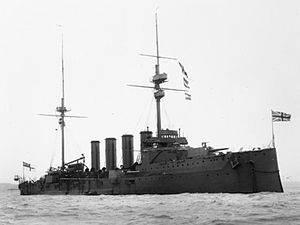
| |
| History | |
|---|---|
| Name | Duke of Edinburgh |
| Namesake | Alfred, Duke of Saxe-Coburg and Gotha, Duke of Edinburgh |
| Ordered | 1902/1903 Naval programme |
| Builder | HM Dockyard, Pembroke Dock |
| Laid down | 11 February 1903 |
| Launched | 14 June 1904 |
| Completed | 20 January 1906 |
| Stricken | 1919 |
| Fate | Sold for scrap, 12 April 1920 |
| General characteristics | |
| Class and type | Duke of Edinburgh-class armoured cruiser |
| Displacement | 12,590 long tons (12,790 t) (normal) |
| Length | 505 ft 6 in (154.1 m) |
| Beam | 73 ft 6 in (22.4 m) |
| Draught | 27 ft (8.2 m) (maximum) |
| Installed power |
|
| Propulsion | 2 shafts, 2 triple-expansion steam engines |
| Speed | 23 knots (43 km/h; 26 mph) |
| Range | 8,130 nmi (15,060 km; 9,360 mi) at 10 knots (19 km/h; 12 mph) |
| Complement | 789 |
| Armament |
|
| Armour | |
HMS Duke of Edinburgh was the lead ship of the Duke of Edinburgh-class armoured cruisers built for the Royal Navy in the early 1900s. She was stationed in the Mediterranean when the First World War began and participated in the pursuit of the German battlecruiser SMS Goeben and light cruiser SMS Breslau. After the German ships reached Ottoman waters, the ship was sent to the Red Sea in mid-August to protect troop convoys arriving from India. Duke of Edinburgh was transferred to the Grand Fleet in December 1914 and participated in the Battle of Jutland in May 1916. She was not damaged during the battle and was the only ship of her squadron to survive. She was eventually transferred to the Atlantic Ocean in August 1917 for convoy escort duties. The ship was sold for scrap in 1920.